Troy Johns fled the housing market in 2004, convinced that a calamity was on the way.
In the two years that followed, imagination wasn’t a big part of a developer’s job description. For a while, the homebuilding formula seemed simple: Borrow as much money as the bank would give, use it to put up as many two-story beige houses as possible, and quickly sell them to eager homebuyers.
Then, home prices plummeted, and the formula fell apart.
Now, Johns has charged back into Clark County homebuilding. He and other developers say conquering the post-apocalyptic housing market requires more creativity.
“When people were just buying houses hand over fist, you could put in a crappy subdivision, and people would buy it,” said Johns of Vancouver. “The market has changed dramatically.”
Johns is reslicing subdivisions to make yards and garages bigger, defying urban planners’ boom-time dreams of density.
Other builders are squishing single-family homes into complexes to cut costs and tap the rich rental market.
With banks on a tight bureaucratic leash, private equity firms have begun specializing in the sorts of projects that now jitter bankers. And year by year, subdivision plans on file with local governments are becoming obsolete — loose-leaf memorials to the neighborhoods a city used to want.
“Everyone’s trying to figure out the market and what people want to buy,” said Chad Eiken, planning manager for the city of Vancouver. With some developers embracing density and others pleading for elbow room, Eiken said, “it’s almost like we need a referral service to match them together and maybe swap.”
‘More for their money’
Today’s homebuyers want smaller homes but bigger lots, said Mike Lamb, a broker for the Vancouver-based Windermere Stellar Group, who closely monitors local sales figures.
“With an aging population, there’s lots more demand for single-level houses,” Lamb said. “The small lot sizes can’t accommodate that reasonably.”
Lamb said he’s recommended that builders reconfigure subdivision plans to allow larger lots.
Johns, whose development company is called Urban Northwest Homes, agreed. At both his Grove subdivision at Southeast 198th Place and Third Way and his Hazel Ridge Townhomes project on Northwest 76th Street and Hazel Dell Avenue, he said he’d eliminated lots from the original plans and added a park.
Today’s consumers “want more for their money,” Johns said.
Johns has been buying subdivisions in foreclosure and remaking them in his vision: energy-efficient, auto-oriented homes on small and midsize lots that rarely go for more than $220,000.
“The last two years, we’ve been buying, buying, buying,” Johns said. “We haven’t had any competition.”
Beyond the banks
In 2005, Clark County builders were starving for land. Today, real-estate experts say, the limiting factor is financing.
“The nuclear bomb that hit the industry here a couple years ago and the resulting fallout have really altered the financing landscape, I think, forever,” said Gabe Terreson, manager for the Vancouver branch of mortgage broker Home Team Funding. “The traditional banks are not lending. They were lending at 100 percent capacity a couple years ago. Now, they’re lending at 5 percent capacity.”
Thanks in part to his decision not to bet on the housing market before the crash, Johns said he and his team “haven’t really had a problem” landing financing from brokers such as Terreson’s firm.
Terreson said he thinks that small to medium developers who can’t self-finance should consider abandoning banks in favor of private equity or hedge funds.
“There’s a lot of money out there,” said Terreson. “It’s just a matter of tapping into it.”
Terreson estimated that private funds charge an extra percentage point of annual interest — 5 to 7 percent to a bank’s 4 to 6 percent.
In exchange, they’ve become “the only place you can get a spec loan,” he said.
Rental boom
Terreson estimated that hedge and equity funds, more comfortable with risk than banks, are embracing a recent shift in the market: the rapid rise in residential rentals in the last year.
Bank financing of these projects was dead in 2010, according to the Barry Apartment Report, which reviews the sector for the Portland-Vancouver area. But apartments have become a favored asset class among investors who see strong opportunities in the metro area, the report said.
That’s one reason private investors have been financing two- and four-plex residential projects, Terreson said.
“They’re very interested in looking at ’plexes, as long as they’re going to be in urban environments,” he said.
Many real estate watchers agreed. Rents are climbing and likely to continue, because the population is now growing faster than the available housing stock.
“I take what the market gives me,” said Mark Zoller, whose family business both develops new homes and operates about 50 rental units around Clark County. “Right now, it gives me renters.”
Zoller said he’s been lobbying to convert a single-family development — Covington Manor at Northeast 97th Avenue and 66th Street in Orchards — into a series of four-plexes.
That’s not because adjoined housing is suddenly popular, he said; it’s because lenders evaluate adjoined housing based on rental potential, not sales potential.
Once you know how to screen for good renters, Zoller said, rental properties can bring in a lot of money.
“I was doing this during the good years, too,” Zoller said. “I was making $20,000 a unit just by selling it, but by keeping it, renting it … after two years of that, that $20,000 turned into $60,000.”
Even Johns, who isn’t in the rental market himself, said he now regularly sells units to investors planning to rent them out.
“We kind of expect the rental market to keep picking up,” he said. “Because of the lack of housing.”



